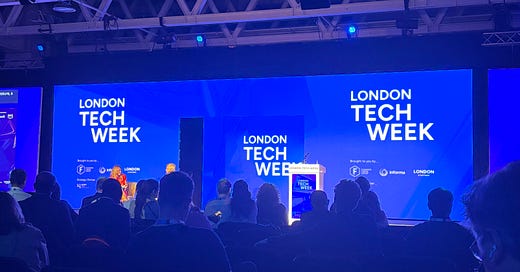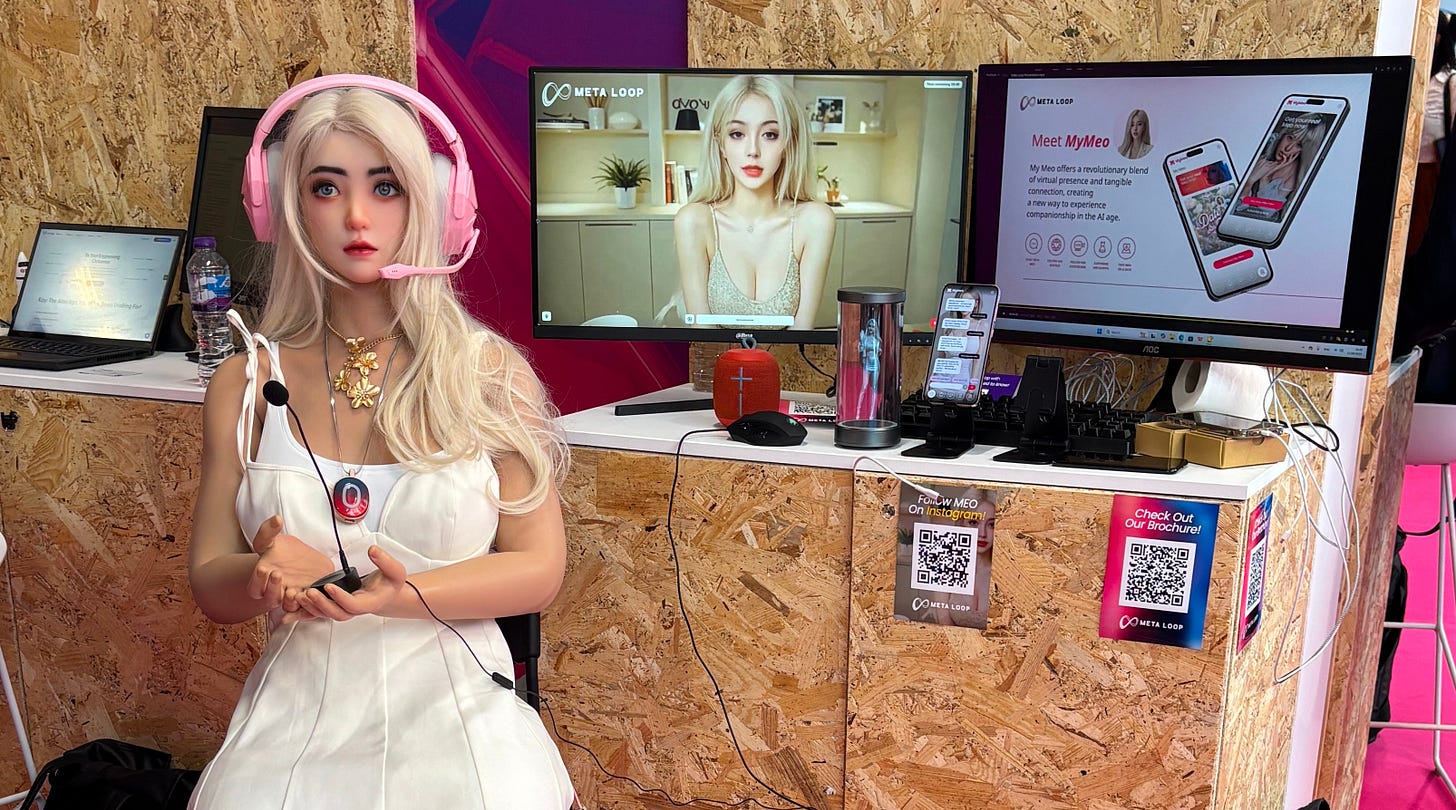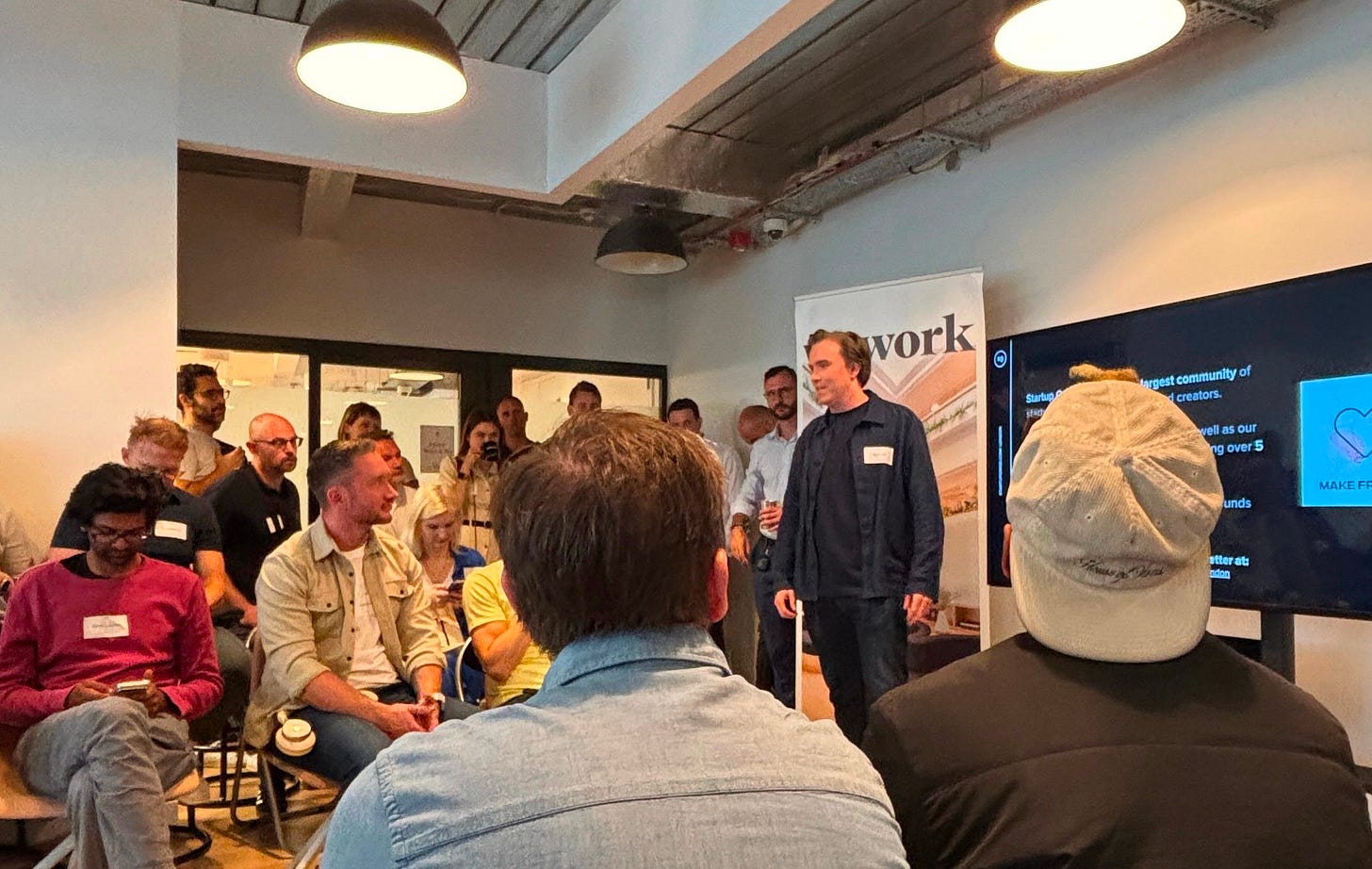Hooked #4
In this issue, we explore how to be more intentional with your brand presence, from happy hour planning to creating spaces your audience actually wants to be in.
This time I’m sending the newsletter a day earlier, as I’ll be one of, what feels like a quarter of the UK population, descending on the fields of Glastonbury Festival this week.
While I’ll be attending as a punter, my event mind has been wandering to how B2B brands might also be able to leverage a consumer festival like Glastonbury. One of my goals—aside from sprinting between stages to minimise clashes on my ‘must-see’ artist list—is to observe what B2C brands are doing and see if there are any learnings to bring back. So look out for Hooked 5 for updates on that topic.
In Hooked 4, my thoughts are still with London Tech Week and just how incredibly untechy the event felt. Read on for my GGBU (Good, Great, Bad, Ugly) event review, plus some tips on aligning the physical space with delegate expectations.
Building Connections With Purpose
Why You Next Happy Hour Needs a Strategy
Despite drawing a solid crowd, happy hours at London Tech Week were few and far between—and where they did happen, most felt like a last-minute tickbox exercise rather than a smart brand play. The reality? If you’re already investing in a stand, a well-executed happy hour can be one of the easiest ways to get relevant people to come back and start creating genuine connections. But to stand out—and reach the right people—you need to align the executive with your purpose for the happy hour.
Here’s how to elevate your exhibition happy hour into a strategic relationship-building moment:
✅ Pre-qualify your audience
You will get some irrelevant footfall from random badge-scanners or people chasing prosecco—but you can still tilt the room in your favour.
• Send out invitations in advance to people you really want to meet, and make it easy for them to add it to their calendar.
• Give out invite flyers during the day to those you’ve had meaningful conversations with. It’s a great way to reconnect casually later.
• Ask friendly partners or neighbouring exhibitors to help distribute invites too—especially those who target the same audience.
✅ Add a hook beyond drinks
Think of your happy hour as a mini activation. That extra layer is what makes it memorable—and relevant.
For example, if you’re targeting startup founders, run a “Top 10 Tech Startups of the Day” live leaderboard, showcasing companies most mentioned on social media during the event. Founders will come to see if they made the list—and stay to talk.
Other ideas: run quickfire founder intros, host a mini fireside chat, or have a dedicated photo/selfie moment with your brand subtly built in.
✅ Anchor it in your brand story
Finally, make sure your happy hour reflects you. Are you all about community? Focus on introductions and creating a warm vibe. Building tech for startups? Make them the centrepiece. If it feels generic, it’ll fade into the noise of the showfloor. If it feels thoughtful, people will remember your brand when they need you.
Interested in improving the success of your next Happy Hour? Book a meeting to discuss how we can help you drive better results.
Event Strategy That Drives Results
Aligning the Physical Space with Delegate Expectations
I would think this was obvious, but as London Tech Week got it so wrong, it’s worth dedicating the space to address this topic. When planning events, aligning the physical space with the delegate’s expectations is essential. It’s not just about what’s said on stage—what people see, feel, and experience across the event must reflect the event’s promise. To do this well, start by clearly identifying:
The event’s core theme
Who the audience is and what they care about
A single audience persona to bring the delegate to life
What that person would expect to see and experience if the event truly delivered
Below are a couple of examples to help you visualise how to think through this process in practice.
Example 1: Technology focused event
Core Theme: Groundbreaking technology and innovation
Audience: Tech leaders, startup founders, investors, policymakers
Persona: You’d want to define a persona for each of the four audience types, but for the purposes of this example, we will focus on the persona for a tech startup founder - Alex, a Series A/B startup founder London based, in his mid 30s, who is time-poor and impact-driven
Alex expects:
To see tangible innovation, not marketing fluff
Immersive demos of real tech, not passive booths
Curated zones that specifically address different types of technology
Live opportunities to meet investors and partners
Clear, creative brand presence from other tech providers further down their journey, he can get inspiration from for his own brand
Example 2: Accounting Conference
Core Theme: The future of accounting — automation, advisory, and regulation
Audience: Mid-size firm partners, accountants, finance leads
Persona: Priya, a partner at a 50–100 person firm, London based in her mid 40s, focused on modernising her practice
Priya expects:
Live software demos that show real use cases for accounting firms
Spaces that reflect advisory work, not just booths
Talent-focused zones that address hiring and culture
Clear walk-throughs from compliance tools to advisory solutions
Smart stands with useful takeaways - such as pricing calculators or firm health check audit templates -, humour, and personality
Once you identify the expectations from delegates, you can then best define the approach that aligns with their interests as well as those of your brand to ensure that the experience is both relevant for delegates and aligned with your purpose.
A great event isn’t just defined by its speakers or agenda—it’s brought to life through space, storytelling, and relevance. When organisers design physical environments that mirror the needs, pressures, and aspirations of their audience, they are building meaningful experiences that drive action, connection, and growth. And when event organisers achieve this, that is when their event truly stands out in the mind of all those in attendance.
Unsure how to understand customer expectations or how to best aligning them with your event space? - Book a 15 min exploratory call with The Hook Studio — we’ll help you create something that aligns delegate expectations with your brand purpose.
The Great, Good, Bad and Ugly (GGBU): Event Review
London Tech Week
In this section, I review recent events I’ve attended, highlighting what worked well, what could be improved and what simply didn’t land. I focus on key areas like audience engagement and experience, communication throughout the event lifecycle, content quality, operational execution, and overall brand impact. Follow The Hook Studio’s Instagram for more GGBU event reviews!
London Tech Week took place from 10th–14th June, centred at Olympia but with 47(!) fringe events popping up across the city. From big-stage talks to niche networking sessions, it was an ambitious attempt to cater to the full spectrum of the UK tech ecosystem. The content was solid—but in terms of creativity and innovation, it felt like the event was playing catch-up with the sector it claims to represent. Here’s my GGBU breakdown—plus a few ideas for brands considering getting involved in 2026.
The Great:
Support for early-stage founders: LTW delivered for startups. Between the pitch competitions, investor office hours, and advisory sessions scattered throughout the week, founders had plenty of opportunities to connect, learn, and get noticed. The fringe events also brought in a wide mix of accelerators, VCs, and angel networks—great energy for those at the start of their journey.
City-wide fringe momentum: The 47 fringe events gave LTW an open, exploratory feel—especially for those who didn’t attend the core conference at Olympia. From invite-only breakfasts to open bar mixers and rooftop showcases, the week offered something for every stage and every timezone. This kind of decentralised buzz is what can really make London Tech Week shine.
If you're targeting startups or founders, LTW’s fringe scene is where the gold is. Don’t limit your investment to the main floor. Host or co-host a fringe event (breakfasts or early evening mixers work well), get involved in office hours or mentorship slots, and consider sponsoring a pitch event in partnership with a VC or accelerator. Visibility in this ecosystem matters—especially when it’s face-to-face and off-stage.
The Good:
Content delivery & sound: The content was wide-ranging, with good thematic structure across AI, fintech, climate, healthtech, and company scaling. The talks’ quality varied a little, but overall it was strong. Sound quality, a frequent complaint at tech expos, was solid—especially at the Innovation Stage where silent disco-style headphones created a focused, immersive experience.
Clear pathways for networking: The LTW app, while not perfect, made it easy enough to connect with other delegates and speakers. The themed networking zones helped orient attendees, and the dedicated hours for casual meetings made the days less chaotic than many similar-sized events.
If you’re exhibiting, don’t just rely on footfall—use the app to pre-book meetings and guide attendees to your stand or hosted event. And, if you’re participating as a speaker, push to be part of interactive formats (fireside chats, roundtables, or Q&A-heavy panels). These got the best engagement at LTW.
The Bad:
Brand activations were underwhelming
Aside from a few companies, the main expo floor felt uninspired. Shell schemes ruled the space, interactive moments were rare, and barely any stands created a sense of discovery. By mid-afternoon, the energy on the floor was fading fast.Limited tech… for a tech event
The floor lacked “wow” moments—very few product demos, immersive activations, or hands-on experiences. For a week that’s meant to celebrate tech innovation, the main venue felt more like a professional services trade fair than a vision of the future.
As an exhibitor, make sure you think outside of the box in the way you showcase your brand so it’s attractive to the tech audience. Follow the process shared in the strategy section of this newsletter (article above) to fully understand the typical persona attending the event and align their interests with those of your typical buyer. What would they value the most to see at your booth and how can you showcase that in your physical space? Bring live product demos, create touch-and-feel experiences, and give delegates a reason to want to stop and talk. If budget allows, go hybrid: keep a stand but host a fringe event elsewhere for deeper conversations.
The Ugly:
Unengaged stand staff: Too many exhibitors wasted their chance to shine. Staff were glued to laptops, chatting with colleagues, or avoiding eye contact while delegates hovered awkwardly nearby. It’s not the event organiser’s fault—but it’s a painful reminder that human connection is what makes live events work.
Connectivity chaos: Ironically, for a tech event, the WiFi was unreliable and the app occasionally buggy. These are minor on paper—but frustrating in real-time, and they subtly chip away at an event’s credibility. LTW should challenge itself (and its sponsors) to not just talk about tech—but showcase it.
Train your stand teams. Set expectations around eye contact, proactive outreach, and engagement. Even better, bring subject matter experts—not just sales reps—to spark real conversations. If you’re showcasing technology, make sure it actually works in a live setting.
London Tech Week 2025 had moments of brilliance—especially for early-stage founders and fringe event attendees—but the main floor needs a creative reset. For a city bursting with innovation, LTW’s brand presence and interactive elements should feel bolder, fresher, and more experiential. As it evolves, there’s a real opportunity for brands to step in and fill that gap.
With the right mix of speaking, fringe hosting, and interactive presence, LTW 2026 could be a huge moment for brands that want to connect meaningfully with the UK tech scene. Let’s hope next year’s edition feels more like the future it talks about.
What Else is On My Mind?
Glastonbury Festival - Yes, it’s a world away from your typical B2B event. But as one of the biggest music festivals globally, the sponsoring brands are bound to bring some bold and interactive activations (or so I hope). Could B2B brands learn a thing or two from how B2C brands show up at Glastonbury? Right now, I don’t know—so I might be shooting myself in the foot for mentioning it—but I’ll be keeping an eye out for ideas we can borrow to make the B2B event world more engaging.
DMWF London - I attended this event, dedicated to digital marketing practitioners, yesterday at Olympia. Look out on LinkedIn and Instagram for an upcoming GGBU review.
Got an event you’d like me to review? If you know of an event that deserves an honest evaluation, send it my way.
Did you enjoy this Hooked newsletter? Have any topics in mind you’d like me to write about? Email me at hello@thehook.studio with your thoughts.
How Can You Support this Substack?
The Hooked Substack is free but you can support it by subscribing and sharing the link with any business owners, marketers, GTM leaders, event professionals or others who may benefit from improving their event strategy to drive more authentic connections and business growth.







